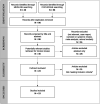Nadir creatinine as a predictor of renal outcomes in PUVs: A systematic review and meta-analysis
- PMID: 37009274
- PMCID: PMC10050680
- DOI: 10.3389/fped.2023.1085143
Nadir creatinine as a predictor of renal outcomes in PUVs: A systematic review and meta-analysis
Abstract
Background: Posterior urethral valves (PUVs) represent the most severe pediatric obstructive uropathy, responsible for chronic renal failure in up to 65% of cases and progression to end-stage kidney disease (ESKD) in about 8%-21% of patients. Unfortunately, renal outcomes have poorly improved over time. The key point is to identify patients at risk; thus, several prenatal and postnatal prognostic factors have been analyzed to improve clinical outcomes. Postnatal nadir creatinine seems to accurately predict long-term renal prognosis, but there is no definitive evidence to support this finding.
Objective: We performed a systematic review with meta-analysis to analyze the predictive value of nadir creatinine on long-term renal function in infants with PUVs.
Methods: We conducted this systematic review according to the Preferred Reporting Items for Systematic Reviews and Meta-Analyses (PRISMA) guidelines. PubMed and Cochrane Library were systematically searched for studies published from January 2008 to June 2022. All the articles were checked independently by two reviewers in two steps.
Results: A total of 24 articles were screened, and 13 were included for data extraction. Data from 1,731 patients with PUVs were analyzed, with a mean follow-up of 5.5 years; of these, on average, 37.9% developed chronic kidney disease (CKD) and 13.6% developed ESKD. All the articles evaluated nadir creatinine as a predictor of CKD, most using a level of 1 mg/dL, with statistical significance at the 5% level. The relative risk of developing CKD in patients with creatinine values higher than the nadir cutoff considered was 7.69 (95% CI: 2.35-25.17, I 2 = 92.20%, p < 0.001).
Conclusions: Nadir creatinine is the best prognostic factor for long-term renal function in patients affected by PUV. A value above the cutoff of 1 mg/dL should be considered a significant predictor for the risk of CKD and ESKD. Further studies are needed to define different nadir creatinine cutoffs for better stratification of the different CKD stages and for the development of reliable scores, which include the association of several variables.
Keywords: chronic kidney disease; nadir creatinine; posterior urethral valve (PUV); posterior urethral valves; predictive factor.
© 2023 Meneghesso, Bertazza Partigiani, Spagnol, Brazzale, Morlacco and Vidal.
Conflict of interest statement
The authors declare that the research was conducted in the absence of any commercial or financial relationships that could be construed as a potential conflict of interest.
Figures



Similar articles
-
Predicting chronic kidney disease progression in children with posterior urethral valves.J Pediatr Urol. 2024 Nov 22:S1477-5131(24)00602-8. doi: 10.1016/j.jpurol.2024.11.008. Online ahead of print. J Pediatr Urol. 2024. PMID: 39648111
-
Posterior urethral valves: Risk factors for progression to renal failure.J Pediatr Urol. 2016 Jun;12(3):179.e1-7. doi: 10.1016/j.jpurol.2015.10.009. Epub 2015 Nov 26. J Pediatr Urol. 2016. PMID: 26705688 Free PMC article.
-
Long-term growth in children with posterior urethral valves.J Pediatr Urol. 2019 May;15(3):264.e1-264.e5. doi: 10.1016/j.jpurol.2019.03.001. Epub 2019 Mar 7. J Pediatr Urol. 2019. PMID: 30948260
-
Chronic Kidney Disease in Boys with Posterior Urethral Valves-Pathogenesis, Prognosis and Management.Biomedicines. 2022 Aug 5;10(8):1894. doi: 10.3390/biomedicines10081894. Biomedicines. 2022. PMID: 36009441 Free PMC article. Review.
-
External validation and reliability assessment of posterior urethral morphology on initial voiding cystourethrogram as a predictor for infants with posterior urethral valves.J Pediatr Urol. 2024 Apr;20(2):253.e1-253.e6. doi: 10.1016/j.jpurol.2023.11.051. Epub 2023 Dec 1. J Pediatr Urol. 2024. PMID: 38129272 Review.
Cited by
-
Congenital Anomalies of the Kidney and Urinary Tract in Down Syndrome: Prevalence, Phenotypes, Genetics and Clinical Management.Genes (Basel). 2025 Feb 20;16(3):245. doi: 10.3390/genes16030245. Genes (Basel). 2025. PMID: 40149397 Free PMC article. Review.
-
Creatinine as a predictor of proliferative diabetic retinopathy among patients with type 2 diabetes mellitus: a systematic review and meta-analysis.Int Urol Nephrol. 2025 Jun 3. doi: 10.1007/s11255-025-04590-3. Online ahead of print. Int Urol Nephrol. 2025. PMID: 40461778 Review.
-
Beyond Childhood: The Lifelong Kidney Risks for Children with Posterior Urethral Valves.J Am Soc Nephrol. 2024 Dec 1;35(12):1633-1635. doi: 10.1681/ASN.0000000545. Epub 2024 Oct 31. J Am Soc Nephrol. 2024. PMID: 39480500 No abstract available.
-
Does unilateral reflux have a protective effect in posterior urethral valve patients?Pediatr Surg Int. 2025 Apr 16;41(1):118. doi: 10.1007/s00383-025-06024-8. Pediatr Surg Int. 2025. PMID: 40240588 Free PMC article.
-
Management of patients with posterior urethral valves "from the fetus to adolescence": French national diagnostic and care protocol (NDCP).Orphanet J Rare Dis. 2025 May 12;20(1):225. doi: 10.1186/s13023-025-03712-5. Orphanet J Rare Dis. 2025. PMID: 40355883 Free PMC article.
References
-
- Manzoni C, Valentini AL. Posterior urethral valves. Rays. (2002) 27(2):131–4. - PubMed
Publication types
LinkOut - more resources
Full Text Sources

